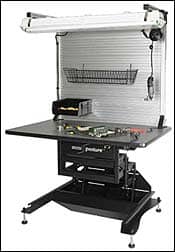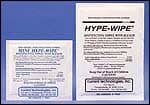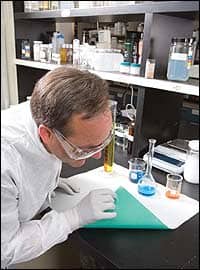Workplace safety for laboratorians remains imperative.
 |
While the life sciences, biotech, and pharmaceutical industries race toward better kits, diagnostics, drugs, instruments, and cures, all these industry branches have a common factor that is often taken for granted: safety in the lab workspace. In fact, safety of the worker who develops products for cures, diagnosis, and disease management while being exposed to chemicals, radiation, and pathogens is imperative in creating a safe, effective, and conducive workplace environment.
In addition to the standard latex gloves, lab coats, goggles, and biohazard workstations, the laboratory safety product line is enormous and continually evolving. Not only are allergen-free gloves or nitrile gloves offered as alternatives to standard safety gloves, ergonomic workstations are the norm, while disposable pipette tips, wipes, and disinfectants are commonplace in any lab setup. Lab safety products have also penetrated the realm of public safety. With the advent of new and potentially dangerous infectious pathogens such as H1N1, H5N1, or norovirus, many lab safety companies have introduced novel and efficient products that can effectively protect the lab worker and the layperson.
Sustainability and Safety
Kimberly-Clark Professional One, Roswell, Ga, has an international health, safety, and hygiene presence with its global brands selling in more than 150 countries. With a 60-year history, the company has innovated many lab safety products focusing on sustainability and eco-friendliness without compromising on quality and efficacy. Kimberly-Clark Professional offers a range of products designed for clean rooms, laboratories, and clean manufacturing facilities for use in laboratories, including protective apparel against blood-borne pathogens and chemical splashes, under the Kleenguard brand name.
The number one nitrile gloves in North America—Kimberly-Clark Sterling Nitrile Gloves—eliminate latex exposure of employees, reduce lost time and employer health costs, and provide good resistance against a range of chemicals. Heather Torrey, marketing manager, states that the innovative packaging also provides 50% more gloves in each box, increasing storage space and reducing waste.
According to Torrey, “Kimberly-Clark Pro-fessional gives sustainability issues related to its products extreme importance. The company prides itself on reduced product packaging and use of fewer natural resources for manufacturing.”
She also adds that the company has been the laboratory industry standard for decades with Kimwipes Wipers and that it is continuing the trend with Sterling Nitrile gloves, the Kimtech Science Benchtop protector, and the WetTask Refillable Wiping System. The company launched an online virtual model to assist laboratory workers in choosing the right protective equipment combination at [removed]www.kimtechvirtualmodel.com[/removed].
 |
| AccuPosture’s Adjus® UpRight and SlatWall System |
El Cajon, Calif-based PURE Bioscience, incorporated in 1992, is another company that has focused on using high-efficacy/low-toxicity proprietary technology to develop antimicrobials and pesticides based on silver dihydrogen citrate-based science. Dolana Blount, chief microbiologist for PURE Bioscience, says, “SDC-based disinfectants have been classed as Category IV (lowest toxicity) by the EPA, making precautionary labels optional. It’s manufactured through a ‘zero waste’ process to create zero by-products. Nothing goes in the trash; nothing goes down the drain.”
Early in 2009, PURE Bioscience announced its agreement with BioTech Medical LLC to sell its SDC-based disinfectant under the brand name SpectraSan24™. The product carries a 30-second kill time on standard indicator bacteria, a 1-day residual kill on standard indicator bacteria, a 2-minute kill time on some resistant strains of bacteria, a 10-minute kill time on fungi, a 30-second kill time on HIV Type I, and a 10-minute kill time on other pathogenic viruses. Independent labs have shown SpectraSan24 destroys MRSA and Vancomycin-resistant enterococcus (VRE) in less than 2 minutes; has a 30-second kill time and 24-hour residual protection against Staphylococcus aureus, Pseudomonas aeruginosa, and Salmonella choleraesuis; a 3-minute kill time against Human Coronavirus (SARS surrogate) and Rotavirus; and a 10-minute kill time against Norovirus, Human Influenza A, and Avian Influenza A (Bird Flu).
Michael L. Krall, president and CEO of PURE Bioscience, commented, “Selling innovative products requires an investment in industry and customer education that then serves as a catalyst to drive the necessary understanding and adoption of a new technology.” Such innovative technologies are now leading toward environmentally sound and “greener” products that can be used equally in the lab and the home. Blount also adds, “That same disinfectant that is ideal for children’s use areas also addresses broader public health threats like MRSA and influenza in environments including mass transit, hospitals, and prisons.”
In the clinical world of blood collection, sample handling, and transfer, Grenier Bio-One, Monroe, NC, has offered products for decades. After developing the VACUETTE® collection system in 1985, Grenier Bio-One is moving toward passive device development. According to the National Surveillance System for Healthcare Workers in hospitals (NaSH), 56% of needle-stick exposure occurs between use and disposal of the device. Passive devices will help eliminate this potentially dangerous situation of uncapped devices.
Launched in 2008, Grenier Bio-One’s QUICKSHIELD Complete PLUS is a fully assembled, individually wrapped, and sterilized QUICKSHIELD Safety Tube Holder and VISIO PLUS Multi Sample Needle. In addition to the safety features of the tube holder, the VISIO PLUS needle has a translucent hub/view window providing visual confirmation of successful venipuncture. The safety mechanism in VACUETTE safety blood-collection sets are designed to activate while the needle is being removed from the vein to protect the patient and the health care worker from accidental needle-sticks.
“Hospitals are looking to cut costs without sacrificing safety. Many phlebotomists like the visual ‘flash’ confirmation of successful vein penetration when using safety blood-collection sets,” said Diane Ban, preanalytic product manager at Greiner Bio-One. “Now, they can get the same visual confirmation using QUICKSHIELD Complete PLUS, which costs significantly less than a safety blood-collection set.”
While new safety technologies and products are being created every year in the fields of clinical setups, hospitals, research laboratories, and blood-collection centers, lab safety products in the conventional sense of the term too are evolving into more sustainable products with lesser consumables and higher efficiencies.
Controlling Biohazards: Boxes, Bags, and (Work) Benches
Alongside industry biosafety leaders, we also have family-owned businesses such as Whitney Products, Niles, Ill, that specialize in low-cost biohazard waste containers and disposable orthopedic tools. The Terminal® brand Floor Model Biohazard Keeper™ offers an easy and economical way to collect and dispose of laboratory waste. The biohazard container, made of corrugated cardboard, is lined with 2 mil red plastic for strength and leak resistance. It also includes the Reclose-A/Remove-A-Lid™, which allows the worker to close the container to reduce odors or to remove the lid completely, as well as allows for permanent closure of the container for disposal when full.
Companies are also gearing toward ergonomic solutions to lab workers who are at their benches for long periods of time. Accuposture Systems Ltd, Bloomfield, Conn, designs solutions for companies looking to improve worker productivity while decreasing occupational injury by offering various ergonomic table and height-adjustable workstations. Products such as the adjusTable System workstations that are faster, safer, and more mobile than current competition include the HDE for heavy-duty electric workstations that payloads more than 500 pounds in 4 seconds, and the LTG, which is a light gas self-sufficient workstation that payloads up to 90 pounds in 2 seconds. Accuposture Systems prides itself in being eco-friendly by using 25% recycled steel and 100% recyclables in aluminum-based products, while its hanging bins are 100% recyclable high-density polyethylene.
 |
| Current Technology’s Hype-Wipe® disinfecting towel |
Spray and Wipe Products: Disposables and Disinfectants
While the standard lab safety equipment include chemical and biohazard hoods, waste-disposal bags and cans, as well as protective gear, it’s the smallest products that pack the punch. EPA-registered HYPE-WIPE® bleach towelettes from Current Technologies, Crawfordsville, Ind, a one-step cleaner/disinfectant with a 1-minute kill time for TB, Streptococcus, Salmonella, and Pseudomonas, and a 2-minute kill time for MRSA, VRE, and Staphylococcus aureus, are an elegant solution for quick cleanup and safe lab space assurance. With an 18-month shelf life, HYPE-WIPE bleach towelettes can be used to disinfect benchtops, equipment, and patient treatment areas, and provide safety, convenience, and portability.
Additionally, Current Technologies offers EPA-registered BLEACH-RITE® Disinfecting Spray as a convenient, premixed, one-step cleaner/disinfectant with a 30-second kill time for VRE and Streptococcus, a 1-minute kill time for Coronavirus (SARS), HIV, MRSA, Hepatitis A, Herpes Simplex, Poliovirus, Rotavirus, Pseudomonas, Salmonella, and Staphylococcus; and a 2-minute kill time for TB. With an 18-month shelf life, the spray is effective on nonporous hard surfaces, with a 0.525% bleach dilution as recommended by OSHA, CDC, and NCCLD.
Not only are these disposables and sprays convenient in the lab environment, they also are options for the public should there be a need during a communicable disease outbreak-type scenario.
Safety for Lab Professionals and the Public: For Lab Workers and Laypersons
With the recent scares of new and developing flu strains such as H1N1 and H5N1, along with other communicable diseases, lab safety companies have taken steps to educate the public. For professionals needing information for flu prevention, Kimberly-Clark Professional offers www.kcprofessional.com/swineflu. Additionally, the company highlights its alcohol-based hand sanitizers, based on CDC recommendations of hand-washing being one of the best ways for flu prevention, as well as supplies N95 protective respiratory masks. But in addition to information, most companies are working toward making lab safety products less toxic so that they can be used in household settings should there be an Influenza A viral epidemic scenario.
 |
| Kimberly-Clark’s Kimtech Science Bench Top Protector |
In May 2009, the EPA listed SDC-based disinfectants (such as SpectraSan24) as effective against the 2009 H1N1 strain based on their effectiveness against other Influenza A viral strains. The CDC has deemed PURE Bioscience products safe for use for H1N1 infection control in health care settings. The CDC advised, “Disinfection strategies used during influenza seasons can be applied to the environmental management of swine influenza.” Consistent integration of SDC-based disinfectants into cleaning protocols at home, at work, in public places, and in institutions provides active protection against the threat of H1N1.
Additionally, another SDC-based product that is being offered to the international market (not yet available for sale in the United States) is PURE Bioscience’s 24-hour re-sidual protection against Norovirus (or stomach flu), Cruise Control. The nontoxic hard-surface antimicrobial is the first such product to work on residual kill, and is marketed to the cruise ship industry to combat such flu outbreaks. According to PURE Bioscience, no other EPA-registered products carry such a residual virus kill claim.
Lab safety has now spilled over to the public realm. Ergonomics has moved from lab benches to computer workbenches at homes and in offices. Protection from pathogens has transferred from bleach sprays in lab-oratories to a plethora of alcohol- and bleach-type products such as gels, sprays, and wipes. The need for nontoxic solutions for human health and safety is important not only to the public but also to lab workers. That is the direction that life sciences, clinical labs, and pharmaceutical companies should focus on while we all work toward a greener and more sustainable biotech industry.
Madhushree Ghosh, PhD, is a San Diego-based science and health writer.
Recommended Reading
- AccuPosture Systems Ltd Web site. www.accuposturesystems.com. Accessed September 10, 2009.
- A closer look at key lab safety players: Greiner Bio-One Preanalytics. laboratory-manager.advanceweb.com/Editorial/Content/editorial.aspx?CC=11459. Accessed September 10, 2009.
- Greiner Bio-One Web site. www.gbo.com/en/index_1554.php. Accessed September 10, 2009.
- Kimberly-Clark Professional products Web site. www.kcprofessional.com/us. Accessed September 10, 2009.
- Kimberly-Clark Professional Web site. www.kimberly-clark.com. Accessed September 10, 2009.
- LSS Safety and Industrial Supplies Web site. www.labsafety.com/clinicallab. Accessed September 10, 2009.
- PURE Bioscience Web site. www.purebio.com/technologies/silver_dihydrogen_citrate. Accessed September 10, 2009.
- VACUETTE® QUICKSHIELD Complete PLUS Web site. www.gbo.com/en/index_2628.php. Accessed September 10, 2009.
- Whitney Products Inc Web site. www.whitneyproducts.com. Accessed September 10, 2009.


